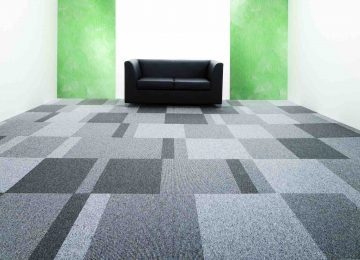At Professional Flooring, we pride ourselves on selling & fitting contract quality carpet tiles at great prices. From premium commercial carpet tiles to quality domestic carpet tiles, our products have the versatility to be used in any setting.
A major decision in the design of any space is the type of flooring you select. The surface you step onto when you enter a space, whether you think about it or not, is your first impression of it. Further, since flooring often makes up a major portion of the project budget, it’s a choice that shouldn’t be taken lightly.

The good news is, with carpet tiles, you really can’t go wrong. The advantages of carpets tiles are many. For one, carpets offer many practical benefits: superior comfort, attractive acoustic, and thermal qualities, as well as greater safety, compared to hard surface alternatives.
Good quality carpet tiles offer so much more than practical advantages, though. The way you deploy it in your design can affect the look, feel and sound of a space. The colours and patterns of your carpet can convey your unique ambiance.

You may be under the impression that landing on your unique, personalised carpet tile design will cost you time and money, or that choosing carpet means taking on installation delays, keeping you from the rest of your design work. With luxury carpet tiles, you don’t have to worry about any of this. Modular, attractive, high-quality and less expensive, carpet tiles are a great flooring solution that makes installation easier.
One of the main reasons architects and designers – not to mention floor fitters – choose to work with carpet tiles is the ease with which they can be installed. Let’s explore the ways carpet can make your installation easier:
- Carpet tiles are easy to lift and transport, making it easier to get them on the job site undamaged, in the first place.
- Carpet tiles, because they’re pre-backed, can be installed directly onto the subfloor, eliminating the need for underlays. This saves a lot of time and effort, not to mention money.
- Carpet tiles don’t always need to acclimatise, or settle in place for 24 hours before they are laid.
- While not exactly recommended, in situations where time is of the essence, carpet tiles can even be laid with furniture in place.
Less waste
Carpet tiles generate minimal waste in the fitting stage. This is because very little cutting, or adjustment, is needed for tiles to fit a given space. This is particularly true of rooms with many nooks and odd angles.

Ease of maintenance
An oft-cited benefit of carpet tiles is the ease with which you can maintain them. Carpet tiles can easily be removed for cleaning, or replaced if a single tile is overly soiled or destroyed. Since tiles are small and modular, they don’t take up much space and can easily be stored. It’s a good idea to have extras on hand so you can sub out tiles as needed. Further, because tiles can be easily lifted, you can readily access underfloor cabling as needed.
Ambience
While wall-to-wall carpet is said to be the go-to option for luxury and plushness, good quality carpet tiles can come pretty close. Cut from broadloom carpet, carpet tiles can often achieve a similar quality to wall-to-wall carpeting. In fact, carpet tiles with their absorbent layered structure, absorb even more structure-borne sound.
Carpet tiles: the cost-effective choice
Carpet tiles are a cost-effective choice suitable for most projects. While wall-to-wall carpets still remain the most popular choice for commercial projects, carpet tiles are gaining traction with designers and architects that realise choosing carpet tiles means saving time and money, as well as reducing waste, without compromising on quality and aesthetics.
While it used to be that carpet tiles were those cheap squares of low-quality carpet that you could only get in a few standard colours, this is just not the case anymore. Technological advancements have made it possible to achieve a great deal of design freedom with a long range of different types of carpet tiles.
You should keep in mind, though, the further you stray from the standard options, the less you benefit from the upsides to modularity. For example, while it’s possible to choose from diverse shapes and apply custom designs to your carpet tiles, doing so might increase the price and make for a more complex and time-consuming installation process.
There are a few other disadvantages to carpet tiles you should keep in mind. For one, even when installed flawlessly, you’ll always be able to see the seams between them. While new technologies have been able to reduce the appearance of seams, if your objective is the look and feel of a single piece of flooring, carpet tiles may not be the right choice.
Further, while you can nearly match the quality of wall-to-wall carpeting with carpet tiles, you generally can’t get the extra plush underfoot feeling that you can with certain wall-to-wall carpets. For most projects, though, designers and architects feel the pros outweigh the cons.
Considering Acoustics When Designing With Carpet Tiles
Nothing’s worse than a place where no matter what you do, you can’t hear the person you’re trying to talk to. This is why acoustics are an important consideration in most projects. Whatever space you’re designing for, with their layered structure, ideal for absorbing structure-borne sound, carpet tiles are a great choice when it comes to reducing noise.
The acoustic performance of a carpet, though, hinges also on the padding, or carpet backing used beneath it. Since carpet tiles are pre-backed, you might be concerned that they can’t deliver the same acoustic properties as, say, a wall-to-wall carpet paired with an acoustic-optimised backing.
You needn’t worry, though. As carpet tiles are very often used in environments, such as offices, where noise is of top concern, carpet manufacturers have followed suit and offer standardised backing solutions with attractive acoustic properties. Further, many manufacturers allow you to specify your carpet tiles with a different backing, to find one that best suit the needs of your project.
To discuss more about carpet tile options, please contact Professional Flooring today
